Friend or Foe?
Wasps — Reviled Pest or Welcomed Pest Control?
By Ann M. Mason, Fairfax Master Gardener Intern
 It is summer. Excitedly, visitors to my house call attention to a large paper nest hanging from a branch in our dogwood tree (Cornus kousa) about 20 feet from my front door. We see the flash of yellow on a winged, smooth, narrow-waisted, bullet-shaped flying insect with a pointed end. Do we run for a can of spray insecticide? “Be calm,” I say. “Most wasps are among the ‘good’ bugs since they prey on crop-devouring and sap-sucking insects, and many play an important role in pollination.”
It is summer. Excitedly, visitors to my house call attention to a large paper nest hanging from a branch in our dogwood tree (Cornus kousa) about 20 feet from my front door. We see the flash of yellow on a winged, smooth, narrow-waisted, bullet-shaped flying insect with a pointed end. Do we run for a can of spray insecticide? “Be calm,” I say. “Most wasps are among the ‘good’ bugs since they prey on crop-devouring and sap-sucking insects, and many play an important role in pollination.”
Let’s take a closer look at this misunderstood group of insects by grouping wasps into two broad groups: social wasps and solitary wasps. This grouping helps describe their behavior toward humans. All social wasps form large nests with many workers and with usually one queen. Social wasps fiercely defend their nests and will sting anyone threatening it. In contrast, solitary wasps are characterized by a single female occupying a nest with her brood. Solitary wasps rarely sting. So, the shape of the nest signals presence and offers us a way to identify wasps and their anticipated behavior to us.
Most common social wasps in Virginia are beneficial, albeit somewhat frightening, insects.

Baldfaced Hornet
The baldfaced hornet
(Dolichovespula maculata) is a large, dark, heavy-bodied, 3/4 to 1-inch long wasp with white or pale yellow marks on the head and end of abdomen. Characteristically, it builds a large oval-shaped paper nest often found hanging from a branch or twig in trees. The baldfaced hornet is a social wasp that feeds on protein such as flies, caterpillars and other garden pests including yellowjacket wasps. It is one of the good, beneficial wasps. The baldfaced hornet will ignore human activity. BUT, like all social wasps, it will fiercely defend its nest and, if the nest is threatened, it will sting. Leave the nest alone unless its location threatens humans. This nest is a one-season home. Once the cold weather comes, this wasp leaves. The nest can be removed safely in late fall and winter. In my case, a bird invaded the nest, either looking for remaining larvae or for a place to call its own, and I knew it was safe to remove it.
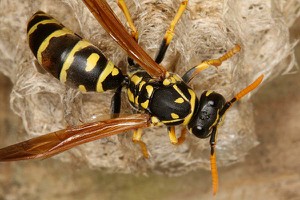
Paper wasp
The paper wasp
(Polistes) is 3/4 to 1 inch long and is generally reddish orange to dark brown in color . It is easily identified by its legs hanging down during flight. It builds an umbrella-like, open-combed nest attached with a slender filament to a sheltered, protected location like a house eave. The paper wasp is a beneficial pollinator as it forages flowers for its nectar. It rids the garden of unwanted pests since it preys on caterpillars and other soft-bodied, insects that harmfully suck the sap out of leaves, plants and vegetables. A paper wasp generally ignores human activity; but like any other social insect, will defend its nest and sting those that threaten it.
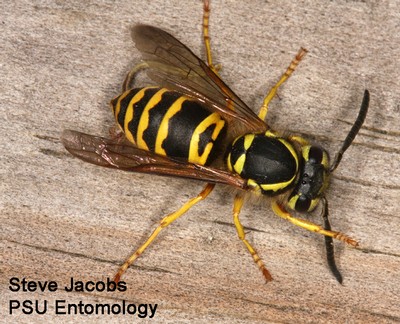
Yellowjacket
The yellowjacket
(Vespula maculifrons) is 5/8 to 1 inch long with fierce-looking sleek yellow and black bands. It is known to build papery nests above ground near human habitation and below ground where it can repeatedly sting the unsuspecting gardener or lawn mower operator, especially in late fall when food sources decline. As a native, beneficial wasp, the yellowjacket feeds on nectar and voraciously preys on living pests, ridding the garden of caterpillars and other insects. However, because it competes to access human foods (meats and sweets) around picnic areas and over ripe fruits in the garden, it has a well-deserved reputation for being a nuisance and a wasp to avoid. See
Yellowjackets.
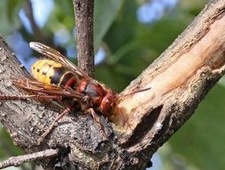
European Hornet
The European hornet
(Vespa crabro) is a stout, hairy, inch-long wasp similar in coloration to the yellowjacket, but with hair. This wasp is frightening when seen singly or with its friends swarming toward porch lights. This social wasp has a bad reputation for chewing the bark from woody shrubs and trees to feed on the resulting sap. Its chewing often results in a girdled band on the plant that dies above, despite attempts for regrowth. See
European Hornet.
Solitary wasps are beneficial wasps that feed on spiders, crickets, cicadas, caterpillars and other pests and rarely sting.
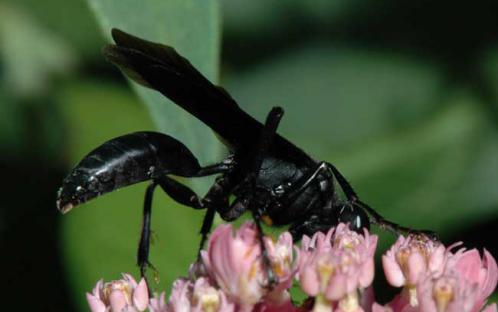
Mud dauber
The mud dauber wasp is dark or metallic blue or black with a long thin waist. It builds a mud cell nest that looks like columns, a pipe organ or circular domes on the side of a home and other structure. It preys on and embeds spiders in its mud “nest” as food for its developing larva. It is a beneficial wasp that is not aggressive and rarely stings. Common ‘organ pipe’ mud daubers are
Tropoxylon clavatum,
T. politum and Sceliphron caementarium, the black and yellow mud dauber.
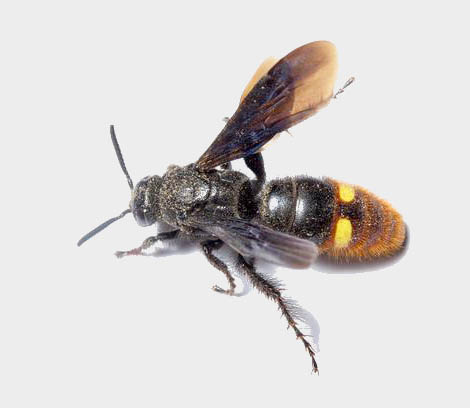
Scoliid wasp
The digger or Scoliid wasp is about 5/8 inch long, slender, and blue-black in color, with red hairs on its abdomen and two yellow strips, one on each side of the abdomen. At rest, the wings of the digger wasp are not folded, a characteristic that distinguishes it from the look-alike social wasp. This ground-nesting wasp is not aggressive and rarely stings humans but is a fierce predator seeking out lawn-threatening grubs. Gardeners welcome this beneficial wasp as one biological control for beetle grubs. Additionally, it pollinates many plants. One digger wasp,
Cerceris fumipennis, commonly known as the ‘Smokey Winged Beetle Bandit,’ preys on many wood-boring beetles, including the emerald ash borer
(Agrilus planipennis) that threatens our trees.
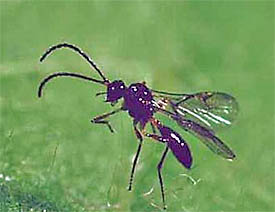
Parasitic wasp
The parasitic wasp ranges in size from very small to about 1 inch long and lives part of its life cycle inside or on a host insect that serves as food for its developing larva. Like other wasps, the parasitic wasp appears to have a segmented body with a ‘waist.’ Unlike other wasps, the female wasp has a noticeably large ovipositor, the egg-laying organ at the tip of the abdomen, which is used to penetrate the body of her prey to lay her eggs. This prey serves as the host food for the developing wasp larvae. Gardeners should welcome the parasitic wasp as a biological control for garden pests, including an amazing diversity of insects, spiders and ticks. For example,
Pediobius foveolatus preys on the Mexican bean beetle. Trichogramma sp. attacks pests of our garden vegetables, including the eggs of the cabbage worm that are a menace of our cabbage, collard, turnip and kale crops. Two parasitic wasps,
Gryon pennsylvanicum and
Anastatus reduviid, effectively limit the population of the squash bug
(Anasa tristis).
With all the good that wasps do for the garden and for our Virginia plants, next time we reach automatically for the spray can, perhaps we gardeners should take a deep breath, back away and look thoughtfully at the wasp while asking several questions:
Are humans immediately threatened or can humans back off to avoid threatening the wasp or its nest?
What type of wasp are we seeing? Is it one of the social wasps defending its nest from a threatening human? OR is it a social or solitary wasp going about its business trying to pollinate, capture predators or manage its nest?
Armed with knowledge, prudent gardeners can discern when to accept the natural biological control offered by wasps to control our garden pests and when to remove wasps from our yards.
Resources
• Parasitic Wasps, Theresa A. Dellinger and Eric Day, Virginia Tech Publication ENTO-74NP
• Baldfaced Hornet, Eric Day, Virginia Tech Publication ENTO-84NP
• Galls Made by Wasps, Eric Day, Virginia Tech Publication ENTO-145NP
• Yellow jackets, Eric Day, Virginia Tech Publication ENTO-49NP (ENTO-316NP)
• European hornet, Eric Day, Virginia Tech Publication: 2911-1422 (ENTO-123NP)
• Mud Dauber, University of Maryland Extension
• Schools Integrated Pest Management (IPM) for Wasps and Bees, Marc L. Fisher and Dr. Dini Miller,
Virginia Tech
• Pediobius foveolatus – A parasitoid of the Mexican bean beetle, Louis Nottingham and Tom Kuhar,
Virginia Tech Publication ENTO-170NP.
• Cerceris fumipennis “The Smokey Winged Beetle Bandit”, Holly Wantuch, Tom Kuhar and Scott Salom,
Virginia Tech Publication ENTO-171NP
• Squash Bug, Hélène Doughty, James M. Wilson and Thomas Kuhar, Virginia Tech
Publication ENTO-64NP
• Integrated Pest Management Ideas for Vegetable Gardens, Virginia Tech Publication 426-708
• Mining Bees & Ground Nesting Wasps, Mary Kay Malinoski, University of Maryland Publication HG104
• Predatory Wasps, Mike Raupp, Jon Traunfeld, and Chris Sargent. University of Maryland Extension
• Paper Wasps, Yellowjackets and Solitary Wasps, Glen C. Moore and Mike E. Merchant, Texas A&M
Extension Service Publication E-239.
• Homeowner Guide to Yellowjackets, Bald-Faced Hornets, and Paper Wasps, Edward Bechinski, Frank
Merickel, Lyndsie Stoltman, and Hugh Homan, University of Idaho Extension Publication BUL 852
 It is summer. Excitedly, visitors to my house call attention to a large paper nest hanging from a branch in our dogwood tree (Cornus kousa) about 20 feet from my front door. We see the flash of yellow on a winged, smooth, narrow-waisted, bullet-shaped flying insect with a pointed end. Do we run for a can of spray insecticide? “Be calm,” I say. “Most wasps are among the ‘good’ bugs since they prey on crop-devouring and sap-sucking insects, and many play an important role in pollination.”
It is summer. Excitedly, visitors to my house call attention to a large paper nest hanging from a branch in our dogwood tree (Cornus kousa) about 20 feet from my front door. We see the flash of yellow on a winged, smooth, narrow-waisted, bullet-shaped flying insect with a pointed end. Do we run for a can of spray insecticide? “Be calm,” I say. “Most wasps are among the ‘good’ bugs since they prey on crop-devouring and sap-sucking insects, and many play an important role in pollination.”





